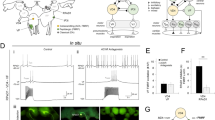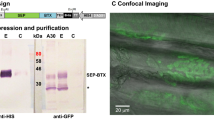Abstract
Octopamine, the phenol analogue of noradrenaline, is a neurosecretory product found in many vertebrate and invertebrate species. In the American lobster, octopamine produces an increase in muscular tension during activation of the motor nerve and may induce spontaneous contractions at concentrations of 10−7 M (refs 1, 2). In the lobster, postsynaptic mechanisms, including a change in Ca2+ conductance of the muscle membrane, are thought to be responsible for potentiation of contraction2. In contrast, studies on insects have implicated both pre- and postsynaptic effects: for example, O'Shea and Evans3 reported that neuromuscular transmission in the locust leg extensor muscle is modulated by octopamine released from a specific neurosecretory neurone which acts on high-affinity octopamine receptors located both on the muscle and on excitatory nerve terminals. The presynaptic receptors mediate an increase in frequency of spontaneous miniature postsynaptic potentials recorded in the muscle4. In view of the apparent discrepancy between insect and crustacean results, we have re-examined the effects of octopamine on neuromuscular transmission in a crustacean muscle and report here that enhanced postsynaptic potentials produced by very low levels of octopamine (10−10–10−7 M) are largely attributable to a presynaptic effect which increases quantal release of transmitter. Also, this effect is more pronounced and longer lasting when octopamine is applied to active neuromuscular preparations. This system provides a model for selective consolidation of active synapses by neurohormonal mechanisms. Such an effect could be of general significance in the nervous system, as it would provide a mechanism for selective neurohormonal regulation and strengthening of pathways used during specific activities.
This is a preview of subscription content, access via your institution
Access options
Subscribe to this journal
Receive 51 print issues and online access
$199.00 per year
only $3.90 per issue
Buy this article
- Purchase on Springer Link
- Instant access to full article PDF
Prices may be subject to local taxes which are calculated during checkout
Similar content being viewed by others
References
Battelle, B. A. & Kravitz, E. A. J. Pharmac. exp. Ther. 205, 438–448 (1978).
Kravitz, E. A. et al. J. exp. Biol. 89, 159–175 (1980).
O'Shea, M. & Evans, P. D. J. exp. Biol. 79, 169–190 (1979).
Evans, P. D. J. Physiol., Lond. 318, 99–122 (1981).
Katz, B. Nerve, Muscle and Synapse (McGraw-Hill, New York, 1966).
Atwood, H. L. in The Biology of Crustacea Vol. 3, 105–150 (Academic, New York, 1982).
Wernig, A. J. Physiol., Lond. 226, 751–759 (1972).
Zucker, R. S. J. Physiol., Lond. 229, 787–810 (1973).
Sherman, R. G. & Atwood, H. L. Science 171, 1248–1250 (1971).
Jacobs, J. R. & Atwood, H. L. J. comp. Physiol. 144, 335–343 (1981).
Swenarchuk, L. E. thesis, Univ. Toronto (1975).
Dudel, J. & Kuffler, S. W. J. Physiol., Lond. 155, 514–529 (1961).
Florey, E. & Rathmayer, M. Comp. Biochem. Physiol. 61 C, 229–237 (1978).
Author information
Authors and Affiliations
Rights and permissions
About this article
Cite this article
Breen, C., Atwood, H. Octopamine—a neurohormone with presynaptic activity-dependent effects at crayfish neuromuscular junctions. Nature 303, 716–718 (1983). https://doi.org/10.1038/303716a0
Received:
Accepted:
Published:
Issue Date:
DOI: https://doi.org/10.1038/303716a0
This article is cited by
-
Autoregulatory and paracrine control of synaptic and behavioral plasticity by octopaminergic signaling
Nature Neuroscience (2011)
-
Synaptic diversity and differentiation: Crustacean neuromuscular junctions
Invertebrate Neuroscience (1996)
-
Differential modulation of chemical and electrical components of mixed synapses in the lobster stomatogastric ganglion
Journal of Comparative Physiology A (1994)
-
The effects of octopamine on contraction kinetics and power output of a locust flight muscle
Journal of Comparative Physiology A (1988)
Comments
By submitting a comment you agree to abide by our Terms and Community Guidelines. If you find something abusive or that does not comply with our terms or guidelines please flag it as inappropriate.



